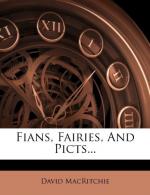FIG. 9.
Dwelling and Dairy joined, “of the usual bee-hive shape, and green with the growing turf.” Dairy “6 feet square on floor, but roundish externally.”
a. doorway; “easily closed with a creel, a bundle of heather, or a straw mat.”
b. “a very low interior doorway.”
c. doorway of dairy.
d. fireplace; “the smoke escaping through a hole in the apex of the dome.”
e. “the usual row of stones.”
f. “a litter of hay and rushes for a bed.”
g. niches in wall.
i j k l. various utensils.]
PLATE II.—Bee-Hive Houses at Uig, Lewis.
(From Plate XXXI. of Vol. VII. of Proceedings
of the Society of
Antiquaries of Scotland, First Series.)
Fig. 8. Captain Thomas selects this as “the most modern, and at the same time the last, in all probability, that will be constructed in this manner”—viz., “roofed by the horizontal or cyclopean arch, i.e., by a system of overlapping stones.” “The woman who was living in it [about 1869] told us it was built for his shieling by Dr. Macaulay’s grandfather, who was tacksman [leaseholder] of Linshader ... and I conclude that it was made about ninety years back."[72]
Fig. 9. Sir Arthur Mitchell says of this compound “bee-hive” house:—“The greatest height of the living room—in its centre, that is—was scarcely 6 feet. In no part of the dairy was it possible to stand erect. The door of communication between the two rooms was so small that we could get through it only by creeping. The great thickness of the walls, 6 to 8 feet, gave this door, or passage of communication, the look of a tunnel, and made the creeping through it very real. The creeping was only a little less real in getting through the equally tunnel-like, though somewhat wider and loftier passage, which led from the open air into the first or dwelling room."[73]
[Footnote 72: Op. cit., p. 161.]
[Footnote 73: The Past in the Present, p. 60.]
[Illustration: PLATE III.
BEE-HIVE HOUSES, FIDIGIDH IOCHDRACH, UIG, LEWIS, HEBRIDES. Inhabited 1859.]
PLATE III.—Bee-Hive Houses at Uig, inhabited in 1859.
(From Plate XII. of Vol. III. of Proceedings
of the Society of
Antiquaries of Scotland, First Series.)
See p. 47, ante.
[Illustration: PLATE IV.
BEEHIVE-HOUSES (BOTHAN) MEABHAG, FOREST OF HARRIS.]
PLATE IV.—Bee-Hive Houses at Meabhag, Forest of Harris.
(From Plate X. of Vol. III. of Proceedings
of the Society of
Antiquaries of Scotland, First Series.)
At the date of Captain Thomas’s visit (1861) a man was still living who had been born in one or other of these dwellings.




